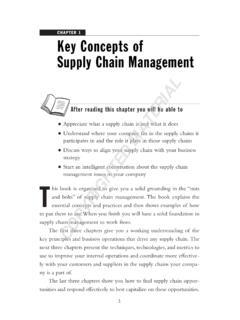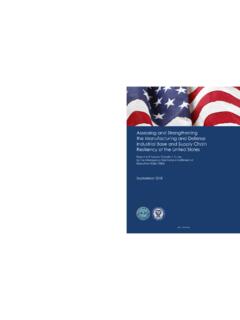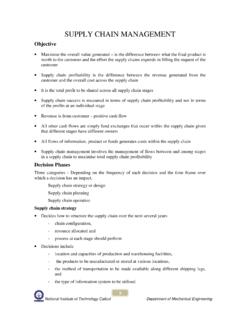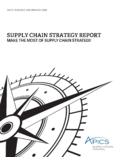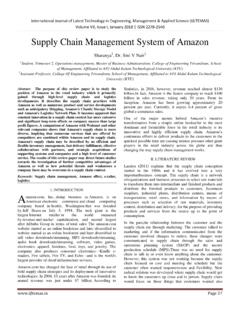Transcription of SCOR: Supply-Chain Reference Model - Tecnoali
1 1 SCOR: Supply-Chain Reference Model ILIM, INSTITUTE OF LOGISTICS AND WAREHOUSING ainia, Technological Centre 1. INTRODUCTION The supply chain Operations Reference Model (SCOR) has been developed and endorsed by the supply chain Council (SCC) as the cross-industry standard for supply chain management. The SCC was established in 1996 by Pittiglio Rabin Todd and McGrath (PRTM) and Advanced Manufacturing Research (AMR), and initially included 69 voluntary member companies. The SCC is an independent, not-for-profit, global corporation with membership open to all companies and organizations interested in applying and advancing state-of-the-art supply chain management systems and practices.
2 All who use the SCOR- Model are asked to acknowledge the SCC in all documents describing or depicting the SCOR- Model and its use. All who use SCOR are encouraged to join the SCC, both to further Model development and to obtain the full benefits of membership. The SCOR- Model is still being developed the latest version of SCOR- Model is numbered SCOR is a management tool. It is a process Reference Model for Supply-Chain management, spanning from the supplier's supplier to the customer's customer. The SCOR- Model has been developed to describe the business activities associated with all phases of satisfying a customer's demand. By describing supply chains using process building blocks, the Model can be used to describe supply chains that are very simple or very complex using a common set of definitions.
3 As a result, disparate industries can be linked to describe the depth and breadth of virtually any supply chain . The Model has been able to successfully describe and provide a basis for supply chain improvement for global projects as well as site-specific projects. The first step the SCC made was to establish a standard vocabulary and a notation that could be used to describe any supply chain . Therefore the first step for a team that wants to use SCOR must be acquiring the same vocabulary, to assure they all talk about the same things in the same way. SCOR methodology assumes that all supply chain processes can be subdivided into one of five general subtypes: Plan, Source, Make, Deliver, and Return.
4 Complex supply chains are made up of multiple combinations of these basic processes. SCOR also defines 3 levels of details (top, configuration and process element). In top the scope and content for the supply chain are defined, at the configuration level the company s supply chain is configured in order to company strategy , at the process element level there is a fine tuning of company s operations strategy and consists of: process element definitions, inputs outputs, process performance metrics, best practices. SCOR uses the historical data of the supply chain to see how it performs and develops, it defines five generic performance attributes and three levels of measures that the analysts can use.
5 Once a company has a good understanding of the strengths and weaknesses of the As-Is process, they are in a good position to think about how they want to compete and what they will have to do to implement regardless from a supply chain strategy they choose. In essence, the SCOR methodology helps companies to create new designs, and then assumes that individual companies will determine how to implement the changes. 22. LEVELS OF ANALYSIS SCOR analyzes a company s supply chain operation in three levels. The Model is based on five different management processes. The processes Source, Make and Deliver of the company, together with those of clients and suppliers, form a " supply chain " planned as a whole by the different actors in the process Plan.
6 Additionally in all the "contact links" Deliver-Source is included the process Return, for the management of returns. LEVEL 1: Top Level (Process Types) At this level 1, companies using SCOR establish basic strategic objectives regarding their operations areas. Level 1 defines the scope and content for the supply chain Operations Reference - Model . Here basis of competition performance targets are set. PLAN: Processes that balance aggregate demand and supply to develop a course of action which best meets the established business rules. To plan the acquisition of prime matters in Source, to plan adequately the production in Make and to fulfil the clients requirements in the delivery in Deliver, it is necessary to be conscious of the demand s variability along the whole chain to avoid the unwanted effect Bullwhip (Accumulation of high inventory levels in the stages of the supply chain that are farer from the final client, which face great variability of demand in comparison with the distributors or retailers).
7 For this is necessary to establish narrow relations with suppliers and clients to plan production in agreement to the demand of the final product. When the product is perishable, it is necessary to have a constant supply system. Every day it is necessary to have fresh inputs, necessary for the production of the day or the week. Likewise the capacity of the productive process must assure a volume adapted to satisfy the internal demand and that of exportation; as for the distribution, the deliveries must be focused to satisfy the delivery times, preserving the quality. Under these considerations arises the need to plan the production according to the different types of demand, for which is indispensable to share information in benefit of all the parts involved (from the supplier s supplier up to the client s client).
8 However, for selected companies that produce raw ingredients and sell processed consumer products, such as dairy co-operatives, problems exist. Inventory planning assumes control of at least one end of the chain either demand or supply . Inventory planning for agricultural businesses is very difficult. If a business can know exactly the quantity and quality of the harvest, the business can then plan the inventory that balances supply and demand. If not, 3the company quickly loses its ability to manage the chain optimally. The best it can achieve is sub-optimal performance. SOURCE: Processes that procure goods and services to meet planned or actual demand.
9 The prime matters are an essential part to assure the quality of the final products. That s why quality standards must be established by the suppliers, to satisfy the final clients. However, the chain must recognise that uncontrollable events will affect the product procured. In the case of agricultural products, input quality variation can depend on environmental and biological factors (rain, disease, etc.). A vendor may have a contract, to clearly identify standards and be a certified supplier, but factors completely outside of the vendor s ability to control, could result in a product delivered that doesn t match established parameters.
10 The inputs can be divided in perishable products (ex: agricultural products) and not perishable (ex: packages). For the case of the perishable inputs, it is necessary that the supply interval is short to support a minimal inventory, the necessary quantity for the daily production. In this point it is very important to support a good coordination in the supply chain , with the purpose of avoiding from high costs of storage for concepts of refrigeration, or for caducity of prime matters. MAKE: Processes that transform goods to a finished state to meet planned or actual demand. In this process it is necessary to take into account all the activities of the transformation process from the raw material to the final product, as well as the flows of material and information of the productive process.

